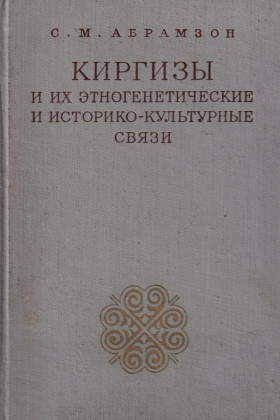 С.М. Абрамзон
С.М. Абрамзон
Киргизы и их этногенетические и историко-культурные связи.
// Л.: 1971. 404 с.
[Переизд.: Фрунзе: 1990. 480 с. ISBN 5-655-00518-2]
Оглавление (развёрнуто)
Введение. — 3
Глава I. Вопросы этнической истории киргизской народности. — 10
Глава II. Хозяйственный уклад. — 71
Скотоводство. — 71
Земледелие. — 86
Охота. — 93
Домашние промыслы и другие занятия. — 106
Глава III. Материальная культура. — 111
Поселение и жилище. — 114
Одежда. — 124
Пища. — 140
Глава IV. Общественный строй. — 155
Глава V. Брак и семья. — 211
Брак с выплатой калыма. — 217
Прочие способы заключения брака. — 229
Свадебный обряд. — 230
Расторжение брака. — 237
Формы, структура и численность семьи. — 238
Полигамия. — 254
Имущественные отношения. — 256
Личные взаимоотношения в семье. — 259
Дети и их воспитание. — 261
Глава VI. Религия и культ. — 267
Ислам. — 267
Культ матери Умай. — 275
Реликты тотемистических представлений. — 280
Культ природы. — 390
Следы фетишизма. — 310
Шаманский культ. — 312
Культ умерших и предков. — 318
Глава VII. Устное поэтическое творчество. — 340
Глава VIII. Народное искусство. — 374
Декоративно-прикладное искусство. — 374
Народная музыка. — 384
Заключение. — 387
Summary. — 394
Список сокращений. — 396
Указатель этнических названий. — 397
Summary. ^
Ethnic history, history of material and spiritual culture of the peoples inhabiting Middle Asia and Kazakhstan represent the resulting product of complex ethnic processes and mutual cultural influences of the population of this vast historic-ethnographical province and neighbouring territories of Front Asia, Transcaucasus and Northern Caucasus, Sub-Urals, Southern Siberia and Central Asia. The Kirghis play a specific role in these important processes.
This book contains the most essential results of more than 40 years research works of the author. It gives generalization and analysis of the data concerning ethnic composition and ethnic history of the Kirghiz, their pre-revolutionary economic structure, material culture, social system, matrimonial relations and family life, religion and worship, oral poetic tradition and folk art. The author also examines the ways which led to the formation of ethnic and cultural characteristics of the Kirghiz people. It would be difficult to explain and interpret these peculiarities without making an attempt first to elucidate various ethno-genetic and historic—cultural ties of the Kirghiz with the neighbouring peoples and the peoples of contiguous territories. For analysis of these ties the author uses a good deal of historic-ethnographical data.
The Kirghiz were developing into nationality during a period of at least 500 years. Ancient-turkish tribes formed ethnic basis of this nationality. In the course of historic development these tribes were entering into close ethnic and cultural contacts with extensive circles of their neighbours, intermixing with them, assimilating them, establishing economic contacts, and forming military- and political alliances. Ethnic processes arising from these contacts expanded the bounds of ethnic nucleus of the Kirghiz nationality, led to consolidation around it of ever-increasing number of tribes, and finally resulted in the formation of new ethnic community — the Kirghiz nationality.
(394/395)
Ethnic processes as indicated above created an ever-expanding periphery of Kirghiz folk culture, drew into ethnic history of the Kirghiz at certain stages not only representatives of Turkish-speaking world but Mongol-speaking and other peoples as well. All this drove the Kirghiz with their mode of life and culture to a peculiar position of being at the boundary of several historic-ethnographical provinces: Middle Asia, Kazakhstan, Southern Siberia and Central Asia in the first hand.
Thus, the Kirghiz appear before our eye both in their own specific ethno-cultural character and in their profound and multi-latteral ties with the peoples of above-mentioned historic-ethnographical zones. These ties more or less intensively affected various aspects of economic, domestic and cultural life of the Kirghiz giving rise to the unique cultural peculiarity and originality material and spiritual culture of the Kirghiz people.
|